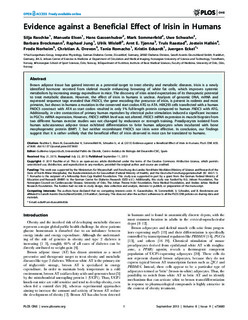Evidence against a Beneficial Effect of Irisin in Humans
Raschke, Silja; Elsen, Manuela; Gassenhuber, Hans; Sommerfeld, Mark; Schwahn, Uwe; Brockmann, Barbara; Jung, Raphael; Wisløff, Ulrik; Tjønna, Arnt Erik; Raastad, Truls; Hallén, Jostein; Norheim, Frode; Drevon, Christian A; Romacho, Tania; Eckardt, Kristin; Eckel, Juergen
Journal article, Peer reviewed
Permanent lenke
http://hdl.handle.net/11250/2360568Utgivelsesdato
2013Metadata
Vis full innførselSamlinger
Sammendrag
Brown adipose tissue has gained interest as a potential target to treat obesity and metabolic diseases. Irisin is a newly
identified hormone secreted from skeletal muscle enhancing browning of white fat cells, which improves systemic
metabolism by increasing energy expenditure in mice. The discovery of irisin raised expectations of its therapeutic potential
to treat metabolic diseases. However, the effect of irisin in humans is unclear. Analyses of genomic DNA, mRNA and
expressed sequence tags revealed that FNDC5, the gene encoding the precursor of irisin, is present in rodents and most
primates, but shows in humans a mutation in the conserved start codon ATG to ATA. HEK293 cells transfected with a human
FNDC5 construct with ATA as start codon resulted in only 1% full-length protein compared to human FNDC5 with ATG.
Additionally, in vitro contraction of primary human myotubes by electrical pulse stimulation induced a significant increase
in PGC1a mRNA expression. However, FNDC5 mRNA level was not altered. FNDC5 mRNA expression in muscle biopsies from
two different human exercise studies was not changed by endurance or strength training. Preadipocytes isolated from
human subcutaneous adipose tissue exhibited differentiation to brite human adipocytes when incubated with bone
morphogenetic protein (BMP) 7, but neither recombinant FNDC5 nor irisin were effective. In conclusion, our findings
suggest that it is rather unlikely that the beneficial effect of irisin observed in mice can be translated to humans.
